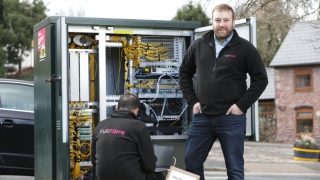CityFibre’s plan to provide superfast broadband to eight million homes by 2025 is well under way.
Construction on the £4 billion project began in Milton Kenes in March 2018 and its network rollout has been progressing at quite a pace, particularly in recent months.
In April, the operator announced it had completed the primary build of its full-fibre network in Milton Keynes, laying about 1,000km of dense full-fibre infrastructure across nearly every street.
The project reaches about 90,000 homes, which is about 90% of residential properties in the area.
The economic impact of the project is massive, according to the company’s estimates. CityFibre says the rollout includes £22 billion in productivity benefits, £4.8 billion from a widened workforce and £1.2 billion from flexible working.
Simon Holden, the group’s chief operating officer, believes that the pace of the rollout is down to the “excellent base of its consumer network”.
Holden joined the company in the newly created position in March 2019 in the midst of its scaling operations across the UK, having previously spent 18 years with Goldman Sachs.
“The reason [readers] may perceive us as moving at a fast pace, certainly faster than all of our competitors, is that we are rolling out across a very big footprint,” Holden says.
The operator is engaged in work that spans 285 cities, towns and villages throughout the UK, having already rolled out its services to 1.5 million homes. It operates the UK’s largest independent full-fibre platform, is rolling out across around 60 major metro areas and has appointed 27 network construction partners across the UK.
Building blocks
Holden believes that building relationships with like-minded partners was “absolutely key” in forging the foundations of the network and being able to build at scale.
“Big ISPs like Vodafone, TalkTalk and Zen Internet want to work with us, and we wouldn’t be here if our partners weren’t putting their efforts behind us and selling on our network,” he says.
Holden also hails the wholesale full-fibre model, which allows separate companies with different geographical focuses to access all networks from one provider.
“I can’t emphasise enough the fact that we have this open-access, wholesale-only model that means we are open to every ISP on the market.”
And Holden expects CityFibre to remain competitive in an increasingly crowded market.
He believes that the company has the scale that is attractive to major ISPs, making it easier to build relationships with the likes of Vodafone and Zen Internet.
Those relationships are key to CityFibre’s continual rollout. Holden says that each time the operator has signed up a new customer, they have broadly been able to express a larger ambition.
“So, with the initial Vodafone deal it was to expand to over one million homes, and as we amended that deal it was to go over five million homes.
“Then when we added TalkTalk, it was to grow to over eight million homes.”
Holden is keen to stress that while CityFibre may not be a retailer, its retail partners are also key – but more so in enabling CityFibre to access more parts of the market.
“We want a broad range of ISP partners who want to be on our platform because that means they are most likely to tap into all the different areas of the market that are available,” he says.
At the wholesale level, Holden says, there hasn’t been any differentiation because customers have mostly either been Openreach or Virgin Media OTT customers.
To provide some context to the competition that CityFibre faces, Openreach’s ultrafast full-fibre network is on track to reach 25 million premises by December 2026 while Virgin Media plans to extend its fibre-to-the-home broadband network to cover around 23 million UK homes by 2027.
Now, he says, alternative network providers (altnets) are providing models that attract investment and government support, meaning “differentiated propositions that come out into the market”.
“Once a broader range of offerings and different levels of service quality are available, I think you will start to see things that really helped accelerate the different ISPs to add to their subscriber base,” he says.
Holden says that the challenge will be how big a network can be in an increasingly competitive landscape.
Investment
CityFibre, though, has significant financial backers, ensuring it will continue to be a major player for years to come.
In September 2021, CityFibre secured £1.125 billion in its latest round of financing, giving it the largest capital raise ever dedicated to full-fibre deployment in the UK.
Alongside this, the firm received £500 million and then a further £300 million from Abu-Dhabi based Mubadala Investment Company, one of the biggest wealth funds in the Middle East.
That also represented the first capital deployed under the new infrastructure vertical of the UAE and UK Sovereign Investment Partnership.
Holden says that partnership covers CityFibre for all the equity requirements of its ambition to bring full-fibre internet to eight million premises by 2025.
“By bringing the capital in and not having to constantly go out and fundraise, we can now just focus on the business and delivery of the network to customers,” Holden adds.
The investment will also facilitate CityFibre’s potential involvement in the UK government’s Project Gigabit programme, which seeks to connect more than one million “hard to reach homes and businesses”.
The government-funded programme will focus on areas that have slow connections and which would have otherwise been left behind.
The firm says that with its passive optical network (PON) technology, networks can easily be upgraded to 10Gbps, 50Gbps or 100Gbps and beyond without any changes to the underlying network infrastructure.
Serving the underserved
Almost half of the locations included in CityFibre’s rollout are categorised by the government as being the top third of those most in need of levelling-up funding.
Closing the digital divide that exists within the UK is important to CityFibre, and Holden says it was a deliberate strategy to target areas that have historically lacked investment.
“We decided we weren’t going to be in London, Birmingham or Manchester and I think we have been very happy with that strategy,” Holden says.
“I think it has set us off with a good opportunity ahead of us, and I think the benefits that we see from counsels from the feedback we get from local customers is they love being on the CityFibre network.”
Holden recognises that targeting underserved areas is a “tremendous investment” that makes a key difference, as opposed to heritage networks that they have been relying on so far.
He adds that CityFibre has ambitions to be in a position where it can connect every home and business in the local communities where it is present.
In order to achieve those expectations, the company is planning to create 16,000 jobs with build partners throughout its supply chain.
As a result, these jobs will generate an estimated £1.4 billion in incremental gross value added (GVA) revenue to the economy and most of those hired will be regionally recruited to support the local build project.
The North of England is set to benefit most from CityFibre’s plans. It will receive £8 billion worth of productivity and innovation gains, the company says. That will add £1.5 billion from a widened workforce, £410 million in local authority efficiency savings and £4 billion in increased house value.
Consolidation
As the UK fibre sector looks forward to a period of sustained growth amid ongoing investment, the sector could be primed for consolidation.
The number of altnets operating in the UK continues to grow, but how many will be able to enjoy success in an increasingly crowded market?
While CityFibre remains a relatively new player in the market itself, the firm will be “opportunistic” if the chance to acquire an emerging fibre company arises.
Holden believes that there are around 10 major players in fibre that are capable of building networks to thousands or even millions of homes, and he firmly expects those companies to be the most active around consolidation.
“We will be one of those in [that 10],” he says.
His expectation is that a large third network could appear in the UK, and this could pave the way for potential collaborations in the coming years.
“At the retail layer, players want a bigger footprint, so it would make sense for some of those alternative fibre players to get together,” he says.
At this time, though, Holden doesn’t see any urgency and says CityFibre’s prime focus is continuing to invest capital to build out its fibre network.









